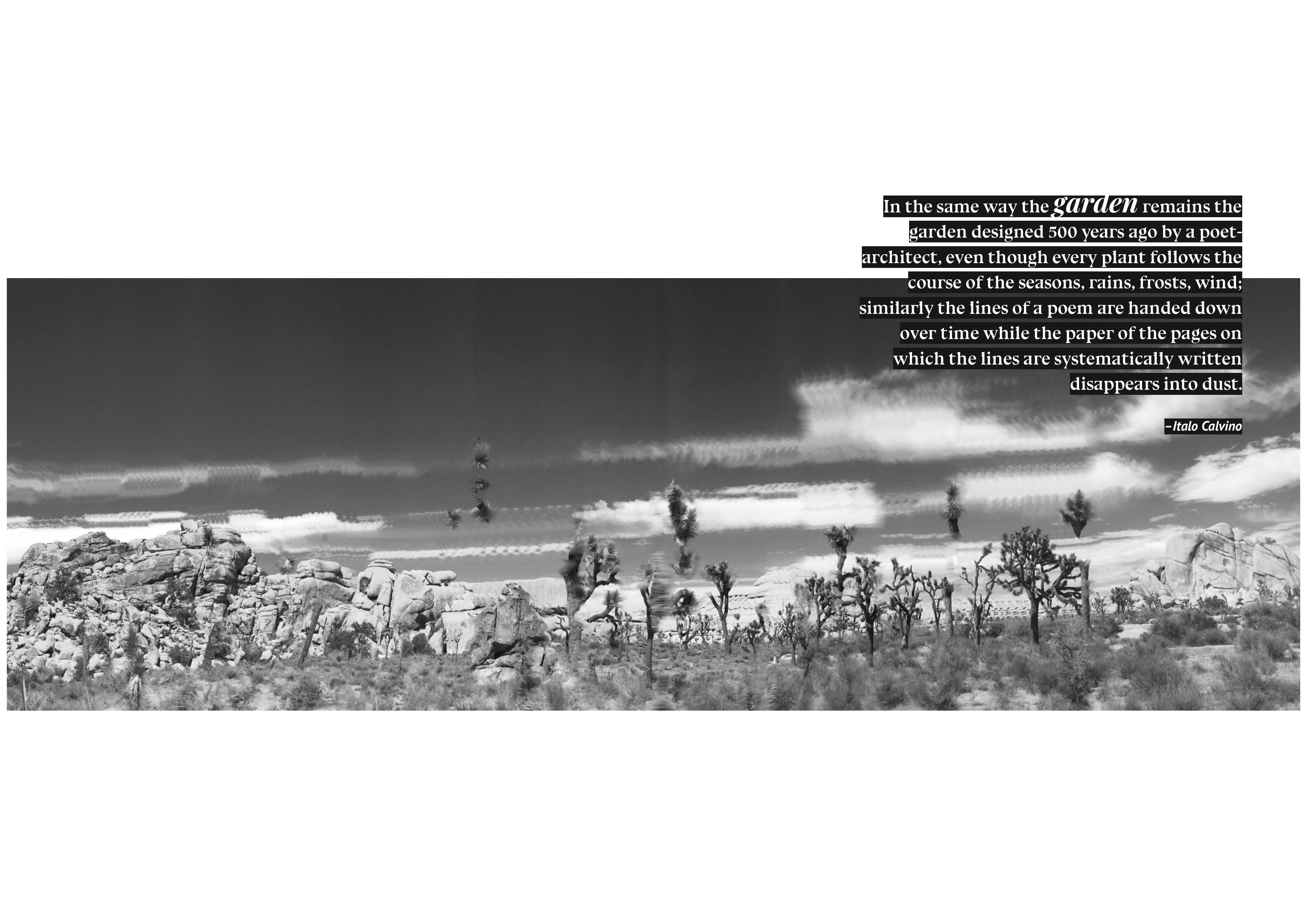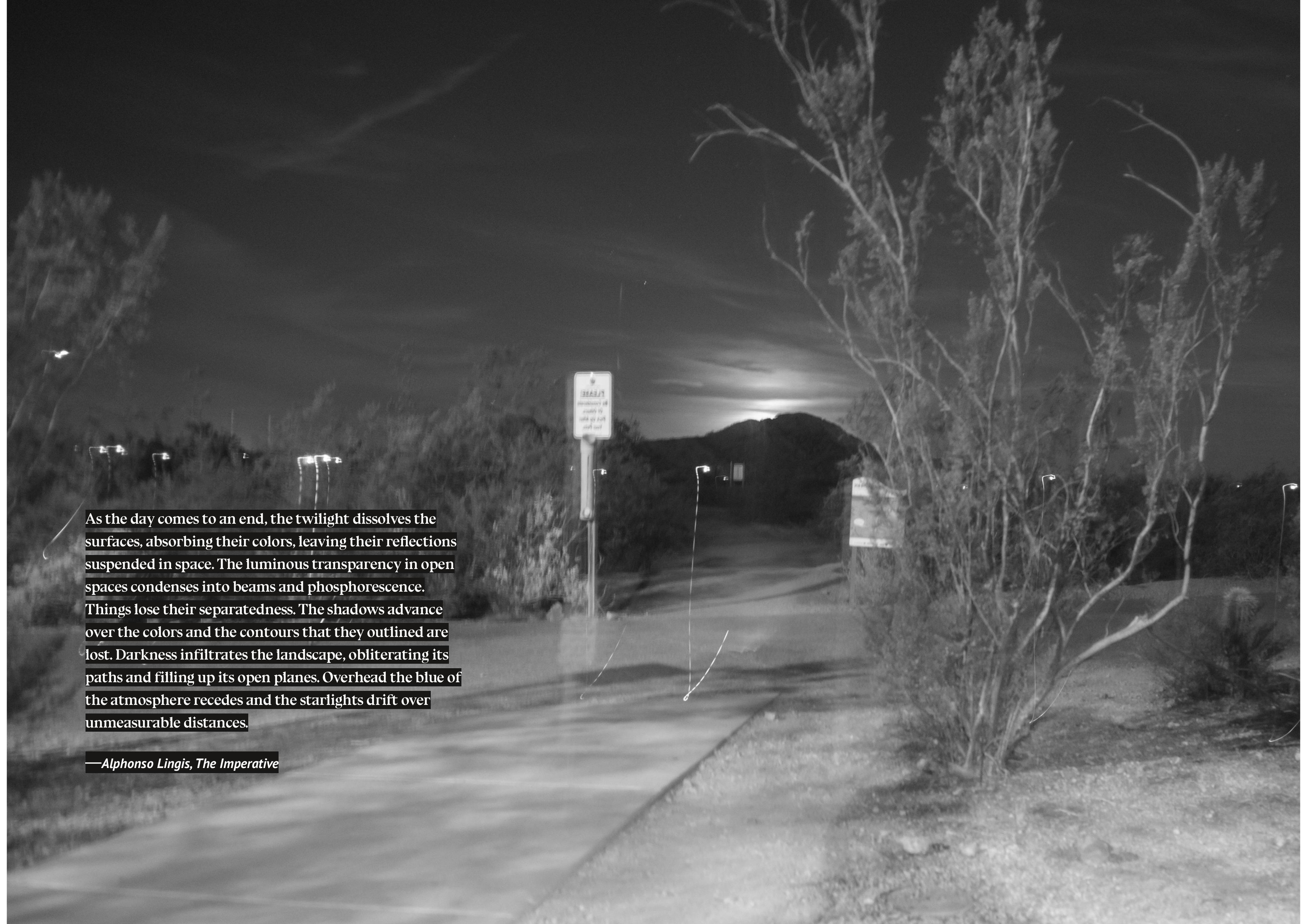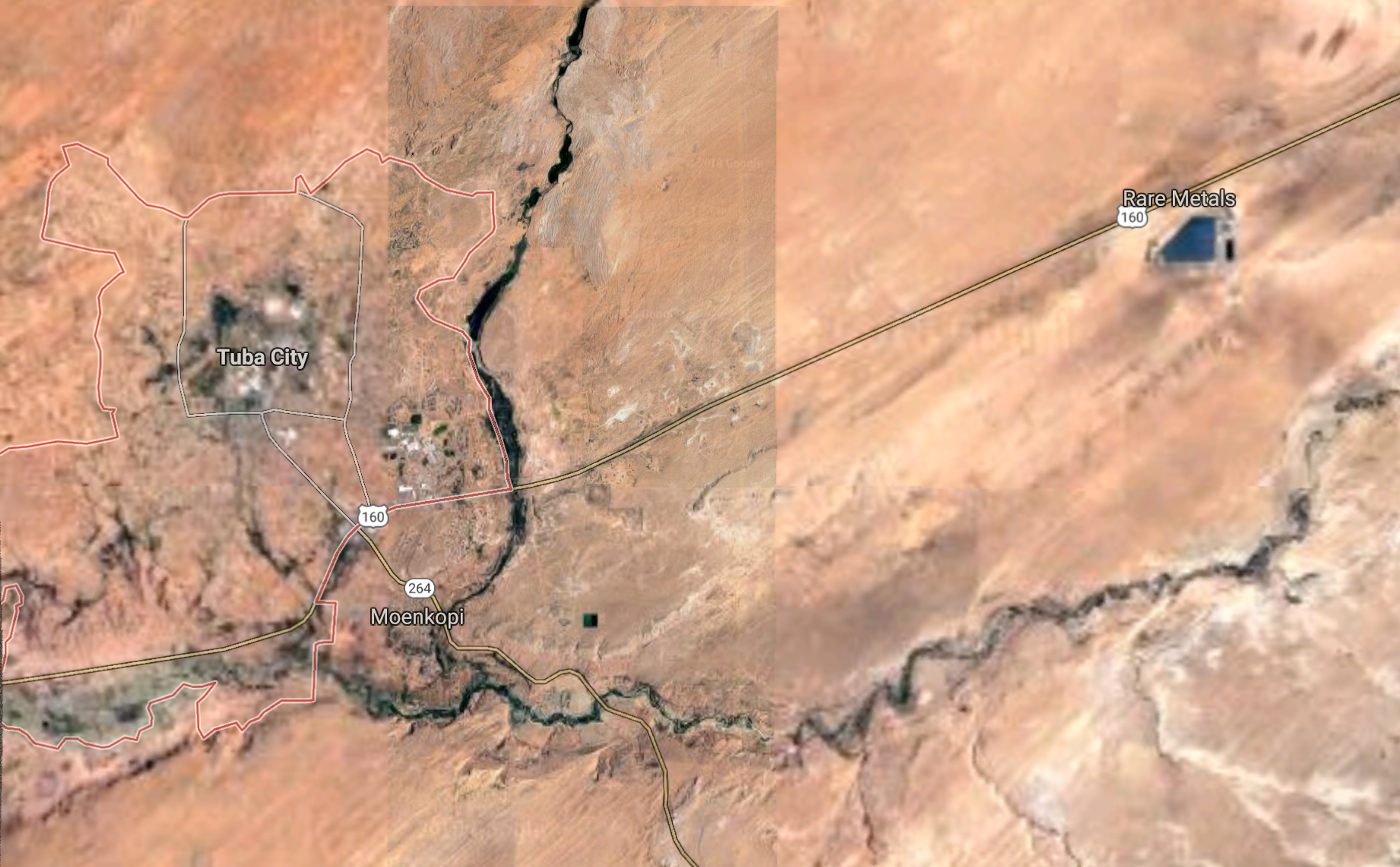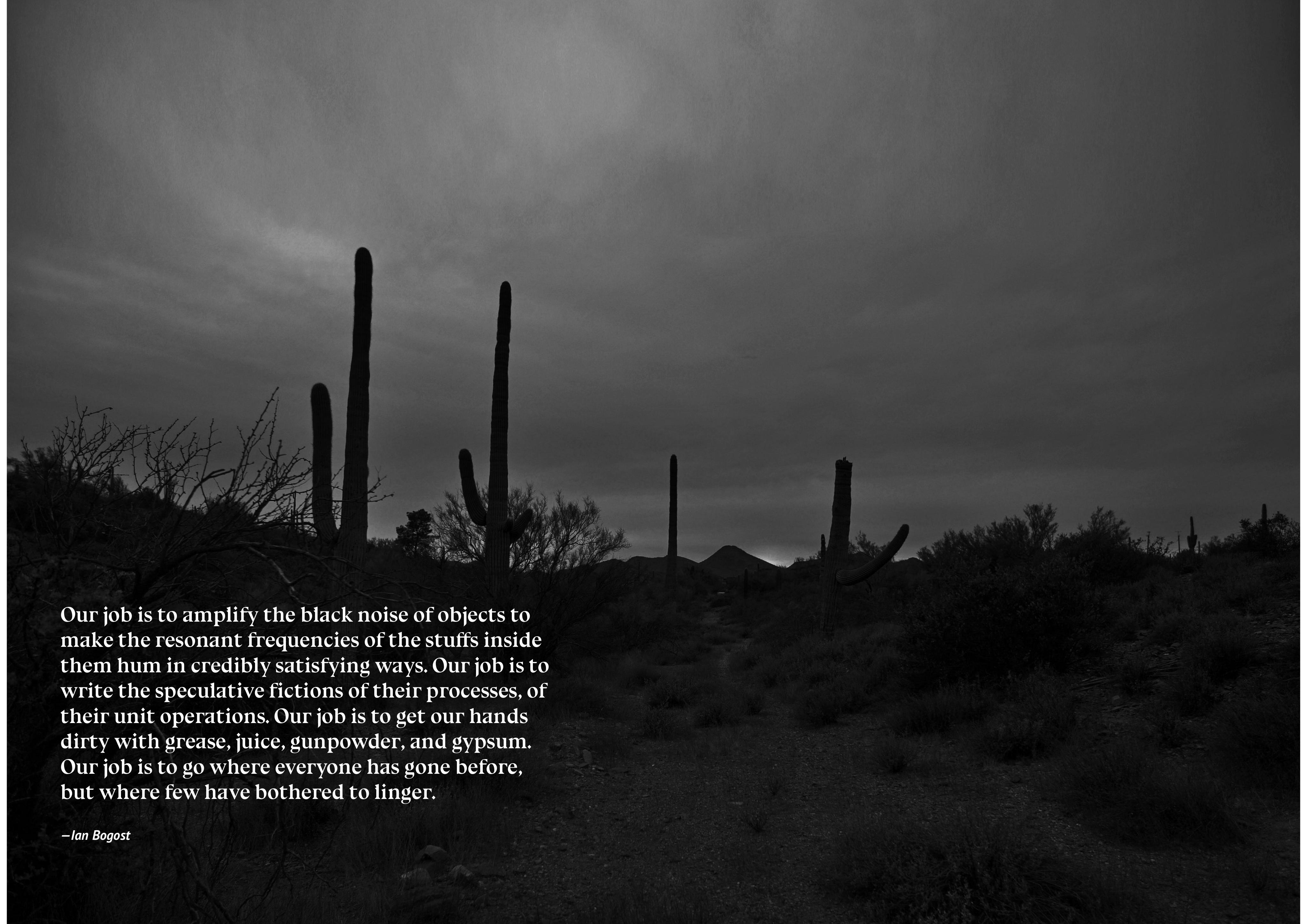Table of Contents
Dust & shadow. Fieldnotes
Text and images from the Fieldnotes booklet, also available in PDF format.
Foreword
by Ron Broglio, Field Marshal of the Animal Revolution
Phoenix, Arizona
33°25'01.2“N 111°55'46.9”W
A twenty-minute walk south from the Salt River, the spine of Phoenix
45ºC, 113ºF, Humidity 7% on the advent of autumn equinox
Phoenix could be just another sprawling metropolis except for the palpable imperative of the ecological surrounds which call to us through inhuman modalities. The desert is filled with visible and persistent reminders of deep time beyond human fathoming — the 1,800 million year old Vishnu basement rock of the Elves Chasm Gneiss at the bottom of the Grand Canyon, for example. This Precambrian “Zoroaster Plutonic Complex” is a marker of a long now that enfolds us. Far above, on wide open plateaus, the sky opens as a field of uninterrupted color blue. The scale of its unstructured blueness is hallucinatory. So far beyond anything the human eyes can take in that it leads to perceptual deprivation, the Ganzfeld effect. Between earth and sky grows unique desert flora —the alien antenna-like structures of tubular saguaro cacti reaching towards the heavens as if sending interterrestrial signals.
To help translate the ecological imperative of desert ecology, my comrades and I called upon our nomadic companions Maja Kuzmanovic and Nik Gaffney of FoAM. Their exercises in non-normative hermeneutics would provide the needed apparatus.
Over two years with multiple site visits we plotted and labored. We set out into the wilds where many a failed utopia bore witness to architectures for understanding that had collapsed under the weight of their own transcendental significance. We would come to terms with the current (unspoken) cultural and ecological worldviews that inhibited messages from the desert and find ways to hack them and open portals for desert attunement. We sketched ways of possible understanding and drew schema across vast walls only to redraw them like a palimpsest of collective Dionysian vision. We constructed devices for hearing the desert and translated its signals as artistic experiments. A soundwalk, an acoustic ecology, a workshop, a seasonal ritual. Traces of these experiences continue to linger on paper, on vinyl, and within the participants. With all of its diverse manifestations, Dust and Shadow is an open invitation for you to bend your sensibilities to the otherworldly world. An invitation to dwell for a while in the desert.
In these fieldnotes, Maja and Nik give us an explorer’s log that reframes the urban and wilderness of the desert. We are grateful for their alchemical work that opens the doors of perception to the unacknowledged presences with which we share the world.
Dust and shadow. Fieldnotes #1
Sonoran & Mojave deserts 020170517 to 020170527
It was as if the city didn’t want to let us leave, pulling us back into it’s humid lethargy. It took us more than two days to leave Brussels (a train accident, flight delays, arcane regulations, etc.) and when we finally landed in Phoenix we were greeted by the dry warmth of desert evening. This was a different kind of warmth, one that glides across the skin rather than cloying and stifling.
We had arrived in the Sonoran desert. A place of desiccated time, layered time, geological, vegetal, human time. Here, time kneads the Earth’s crust into deep folds, cracks and canyons. Plants lay dormant through cycles of drought or grow slowly for centuries, bursting into blossom after the first rains. Humans come and go. Blown through the ages like tumbleweeds. Things don’t really decay here. They shrivel, dry up or slowly rust, yet remain present, as they gradually erode into dust. A thick, dusty atmosphere of things that were, things that are and things that might be. Densities and intensities coagulating on a larger than human scale, illuminated by stark light or lurking in the deep shadow.

Our first impression was that of sprawling suburbia, a seemingly endless grid of ordinal numbers and presidents. A city of three million people keeping the desert at bay. Yet the desert refuses to be tamed. The dust from the big “beyond” blows across the streets on the hot wind. It covers all surfaces, forms a thin crust and penetrates everything. A reminder that the heart of darkness is our neighbour. Hidden beneath otherworldly rocks. A vast expanse with “outstanding opportunities for solitude” protected by the Wilderness Act and it’s own indifference. A vastness that remains incomprehensible despite various attempts to focus and frame it, from early Hohokam sites to contemporary land art. James Turrel’s “Air Apparent” frames the intense blue within a skyward metal square. The ruins of the Casa Grande are host to an array of sky-holes focusing sunlight and moonlight. Lines and openings to mark solstices and equinoxes. One specific aperture oriented in such a way that it illuminates each 18.6 years during the lunar standstill. An inert architectural element activated during an event of ritual significance. From place to time, from earthly to cosmic.
Our bodies experience a radical disjunction. Skins used to the swampy conditions of the European Lowlands begin to crack and itch. Temperature rises above 40ºC (105ºF). Despite the discomfort, the desert draws us in. Inhospitable and otherworldly, alluring and addictive. A resonant, experiential alterity. Neither “the mirror” nor “the lamp” will serve us here. We need (to become) human receptors and listening devices. Practicing the craft of silence. Heterogeneous hearing. Tuning to the world.
There are others here listening too. An incomprehensible historical grammar of rock formations. Alien plant morphologies with antennae into parallel presents and alternate futures. The rustle of slithering reptiles, the buzz of invisible insects and thick webs woven by secretive arachnids.
I dream of a hard and brutal mysticism in which the self merges with a non-human world and yet somehow survives still intact, individual, separate. Paradox and bedrock. Edward Abbey

The world speaks to us in material forces. We gradually begin to sense its overlapping relational fields. Other-knowing, co-existence and reciprocal engagement. Communing rather than examining, cross-pollination rather than exploitation, reconciliation rather than reduction. We came, this time, to this place, to observe before interacting. As Karl Schroeder’s Thalience suggests, to “give the physical world itself a voice so that rather than us asking what reality is, reality itself can tell us.” So, what would a “thalient” laboratory in the Sonoran desert look like?
The heartland of zombie utopias
The desert seems to invite an unencumbered experimentation. The savage romanticism of the Wild West. “Let’s just try it out”. This isn’t a place to hesitate. The desert is unforgiving. There are no maybes, no compromises. A polar opposite to our point of departure. Yet people do try. “You have an idea? Great. Show me that it works.” A heuristic culture of trial and error.
We sought out the consequences of misplaced experimentation. Of experiments out of place. Of human intervention in habitats generally inhospitable to humans. “There were people here and now they are not”. The Hohokam tribe populated the Sonoran desert for centuries, then disappeared. The name Hohokam itself translates to “All used up” or “those who are gone”. A human civilisation with an expiration date. A déjà vu? A signal? Phoenix becomes a Hohokam perpetuation holding onto the promise of permanence. Has Phoenix risen from its ashes, transformed? Or are the ashes still to come?
We take the I-10 west, driving past dreams of free settlements crumbling in the unrelenting dryness and heat. Ghost towns, haunted utopias, evaporated opportunities. Human dwellings abandoned and desiccated. A scattering of burned cars, shot-up rusty cans. Guns and God. Forgiven, yet not absolved. Desert center, Amboy, Eagle mountain mine. Waste. Waste of space. Waste and space. It seems easier to abandon than maintain here. Engineering mistakes leading to inadvertent ecological transformations. The accidental, yet complete drainage of the Colorado River in a series of mishaps that produced the now semi-living Salton Sea. First Solar’s energy farm and unintended soil erosion machine. The arid confluence of Joshua Tree National Park where the Mojave and Colorado deserts meet. Why even attempt to build cities in the desert? As Becket echoes “Try again, fail again, fail better.”

We are witness to grand visions refusing to fade from matter to memory. Domed structures barely holding onto existence. Failed experiments hovering in some zombie half-life; Biosphere 2, Arcosanti, repeating groups of eight. Half dust. Half baked. What would a banishing ritual for these haunted utopias look like? Could they be transformed, or gradually reused and recycled, like airplanes in the Tucson boneyard (309 AMARG)? There are always risks to experimentation. Most recently visible in techno-utopian experimentation. The Alcor Life Extension Foundation in Scottsdale keeps ongoing records of “Suspension failures” in cryonics. The New Age slant on spiritual tourism in Sedona can provide salve, scandal and swindles. Neoreaction (Dark Enlightenment) and New Age existing as each-other’s flipsides, collapsing the complexities of uncertainty into a few select parameters or platitudes. The questions that current uncertainties give rise to can't be answered by a reversion to a mythical “golden age” or mistaking a local maxima for something more. These are perhaps, warning signals of the pre-modern perverted, good intentions gone astray, of confusions between signal and noise. So, how can we animate non-modern sensibilities without becoming entrapped by dualisms of light and darkness, good and evil, us and them, love and power?
Animism, animation, re-animation
How do we translate animist attitudes towards the interconnectedness of all life into worldviews compatible with contemporary (or future) techno-materialist societies? We mulled over romantic poets and romantic machines, process philosophy and the creative process, experiential topology and phenomenology, enchantment, ecology and non-modern practices. We lingered in the contested terrain of panpsychism, where psyche is not “just” mind but soul, breath, life, vitality, being. Would “panexperientialism” be a more suitable term? Or should we refrain from speech and use the visceral language of experience? How do we speak of relations as well as things? In many languages (including Mayan, Turkish, Thai, Vietnamese, Japanese, Tibetan) relational nouns describe movements, relationships between things. Our language could liquefy, become unstuck, mutate on occasion, from ceremonial to the everyday. Communicate to connect rather than dissect.
Perhaps we’re after a humanist (or at least humane) view without anthropocentrism, balancing on a fine edge between social constructivism and social engineering. Moving from social contracts to a natural contract. From value to valuation (of matter, of ecology, of experience…). From sequential decisions to layered selections. From static matter to a space of operation. From the frame to framing. From facilitating to communing, catalysing and spawning. How do we decentre without falling into the abyss of nihilism? Finding and cultivating places of care, empathy and conviviality within the contemporary worlds. Increasing the porousness between interiority and exteriority. From the space between the cells to the space between the stars.
To engage with animism necessarily involves being provoked to think more carefully about what it means to be a person. [T]he understanding that persons always live in relation with others and, in animist communities, are regularly encouraged to act respectfully — especially towards those one intends to eat. That is, this animism is always local and specific. It might not be at all romantic, transcendent or esoteric, but might instead be quite practical or pragmatic as people negotiate everyday needs. Graham Harvey
Amidst the many traces of human failure, we felt a pervading sense of possibility, of resonance, confluence and synchronicity. Nearing the adjacent possible. From myth making to re-animating myths and re-activating inert (geological or architectural) markers. Geomancy. Material wonder. Walking. From shinto to shamanism (and back again). In sacred refugia and wild sanctuaries. Vaporous thoughts condensed into propositions, commonplaces and fieldguides. ∆[∆] …until all our material traces erode and conjoin with countless dust particles in the ever expanding desert.
Dust and shadow. Fieldnotes #2
Sonoran desert 020171123 to 020171206
Thanksgiving. A convivial gathering around a long wooden table, laden with food and filled with laughter. The familiar cadences of a feast, yet one with unfamiliar origins. We were temporarily adopted, welcomed as returning family. Kith and kin, ken or kin. Akin. Some rootless others uprooted, weathering the end-of-term academic storm. A temporary intensification of familiarity. Threads are picked up from conversations months old. Our relationships with FoAM’s distributed clan have begun to follow more closely the rhythms of nomadic journeying. Deep and involved when we briefly occupy the same spatiotemporal locus, loose and relaxed while we travel elsewhere. An irregular pulse of welcomes and farewells, of subsuming and letting go.
We spent two weeks on and around The ASU Tempe campus— immersed in university life and surrounded by urban sprawl — inquiring about the relationships between people and the desert. Uncovering the mythical foundations of contemporary lifestyles. Seeking out counter-myths more closely attuned to the desert environment. Exploring the topological spaces of bodies as fields, bodies as listening devices. Creating propositions, designing experiments and publications. Conversing. Reading. Listening. Aligning. Futurecrafting. Socialising. Falling asleep and waking up to the sound of airplanes and air-conditioning.
From time to time we would follow the edges between city and desert. Searching for sites of dust and shadow, where the city-desert and the wilderness-desert entwine. The Piestewa peak, Moeur park. We followed shadows along the abandoned “Cut” of a railway that was not to be, in the remains of utility poles, in the cairns beneath a flight path and a wetland between two highways. We traced a path of divination. In the delirium of heat and jetlag, we hiked into the Superstitions in search of the mythical source of dust storms, finding enigmatic petroglyphs and a dry creek bed. From our higher vantage point the city became a mirage, merging into the hazy plain punctuated by saguaro cacti. Centuries of human inhabitation evaporated in that mirage. Occasionally re-appearing with small groups of hikers, a procession of jeans, t-shirts, trainers, ball caps, water bottles, snacks, dusty sunglasses. At full-moon, we joined a larger group for a night walk in the liminally illuminated Papago park. Silence without stillness. The hum of internal and external traffic pulling at our attentions and perceptions.
We watched The Last Angel of History speak of fractures and dislocation, weave musically and deploy science fictions in which alien ships take on multiple sinister meanings. A stark contrast to the narrative simplicity of the exhibits at Superstition Mountain. We listened to the Legend of the Lost Dutchman, a story of places where people, treasure, mines and even whole towns vanish into the landscape, never to be found. We traversed personal and cultural memories in search of an experiential imperative. Sacred objects, collected materials and traces of the desert across suburbia became text. A tuft of coyote’s fur, a date, a red rock, a cholla spike, and a drop of mezcal, drunk with friends under the vast, darkening skies.
Deserts possess a particular magic, since they have exhausted their own futures, and are thus free of time. J.G. Ballard. The Atrocity Exhibition.
List 1
- C14 Clocks
- Mythologies
- Xenogenesis
- City and the City
- Reclaiming animism
- Governing the Commons
- Anthropology in the time of the Anthropocene
- The mushroom at the end of the world
- The Enchantment of Modern Life
- Body ritual among the Nacirema
- The good natured feminist
- The last angel of history
- Customs in Common
- Humankind
- Anathem
- 2312
Phoenix and its environs simultaneously fascinate and distance.
Our daily walk between the Anyplace AirBnB and Lab for Critical Technics (LCT) offered a brief opportunity for casual ethnographic study. We were greeted warmly each morning by “Mexican” construction workers. The traffic light (with frog-like certainty) ordered us to “WAIT” for the endless multi lane procession of cars (single driver predominantly, with an occasional “driverless” vehicle). The dispersed choir of homeless veterans from the Endless War droning in refrain under their most inventive shades. “Spare any change for a vet?”. Nearby, the Salvation Army Cafe serves Matcha Latte while half-finished buildings advertise their future as generic condos.

On campus, The Biodesign Institute grows new copper-clad extensions, while the English department is shuffled further from the daylight. ASU is offering exchanges with an Australian university to study cancers affecting the Tasmanian Devil. We enter the Synthesis Center, where clouds and simulated plants dance in responsive patterns around us. Outside, students are rushing to-and-fro fuelled by coffee in take-out cups. In front of a strip mall, cars are left running to keep the heat at bay. Arriving at our temporary studio in LCT, we watch as our hosts unload a pack of plastic water bottles. Tap water quality is troubling, they inform us.
Even our short commute across Tempe suggests that environmental issues are an inextricable part of entangled social, economic and political realities. As China Miéville points out “Arms trading, dictatorships and murder are environmental politics.” They cannot be separated from pollution, climate change and renewable energy targets.
Dust Kapital
What are the environmental politics in the North American South West, specifically to life in the desert? What are the implications for the people, plants, plastics (etc.) and the environment they live in? What peculiar futures or parallel presents exist in this “Valley of the Sun”? What new worlds can emerge from a region swayed by the unpredictability of heatwaves, poor water distribution and over-enthusiastic promises of the tech industry?
We travelled through layers of signals, systems and stories in search of the hardened sediment of metaphoric undercurrents. The libertarian ethos and protestant work-ethic ration desert time into a neurotic drip and trickle of temporal scarcity. Time is submitted to a relentless economic valuation. There is an inherent trust in “the market” as regulatory system. Politicians gamble with a growing population, in a labyrinth of tax benefits, cheap real-estate and myopic risk tolerance. Scale up Arizona’s 5Cs (copper, cattle, cotton, citrus and climate.). Work must continue, no matter the conditions, in the “Sand of the Free, Sprawl of the Brave”. School starts in the hot, sticky month of August as kids hold tight to youthful curiosity while navigating a system caught between funding cuts. Idleness is still considered the devil’s playground, siestas close to sacrilege. A distrust of “elites” and the rhetoric of self-reliance encourage a culture of conservative individualists and a precarious belief in the Dominion of Man over Earth.
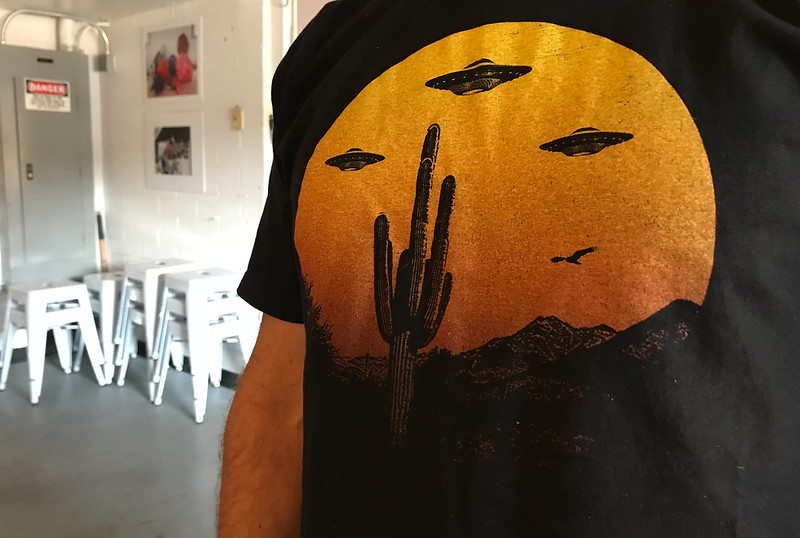
Water rights and food sovereignty stretch public infrastructure close to breaking point. Environmental problems tend to be tackled as single issues with inventive technological solutions. Water banking from CAP & SRP is increasing reserves in the sub-basins beneath the Phoenix metro area. At the Palo Verde Generating Station nuclear reactors are cooled by sewage from nearby towns. Non-native oranges now thrive across the state. The “Smart City” of Belmont is taking root, born in a fever dream of real-estate speculation and the shimmering promise of technology. Yet a larger concern remains; Phoenix exists far from equilibrium, requiring massive external inputs for its continued existence. Despite the desert, not with the desert. Holding onto an idealised image of urban life, haunted by the shadow of its possible demise. Kept alive by snow melt. Water, power and other essentials imported from afar to maintain the appearance of a stable oasis. The myth of the Wild West in a desert on demand. The purity (and dread) of the Wilderness kept at arms length, only to be occasionally appropriated for solitary transcendence, urbophobian escapism and utopian experimentation. Where both nascent and long gone ways of life overlap. A “Tech Bro Guru” finds his place in Sedona as a “polyamourous cult leader” wrapping a very contemporary hollowness around huckster tricks and Barnum effects. Alongside King Clone (the unassuming 11,700 year old creosote bush) lie the ruins of a vanished Pueblo Grande. And yet, here too could be found the American Gods, time-unbinding desert monks and the Dionysian world of the Carnivàle.
All is shadow mixed with dust, and there’s no voice but in the sounds made by what the wind lifts up or sweeps forward, nor silence except from what the wind abandons. Fernando Pessoa, The Book of Disquiet
List 2
- The Wilderness Act
- The Dark Mountain
- Hope in the Dark
- Ecology of Mind
- The Imperative
- Solarpunk
- Dust studies
- Dark ecology
- Book of Sand
- Minutes to midnight
- Too like the lightning
- In praise of shadows
- Autobiography of Red
- Staying with the trouble
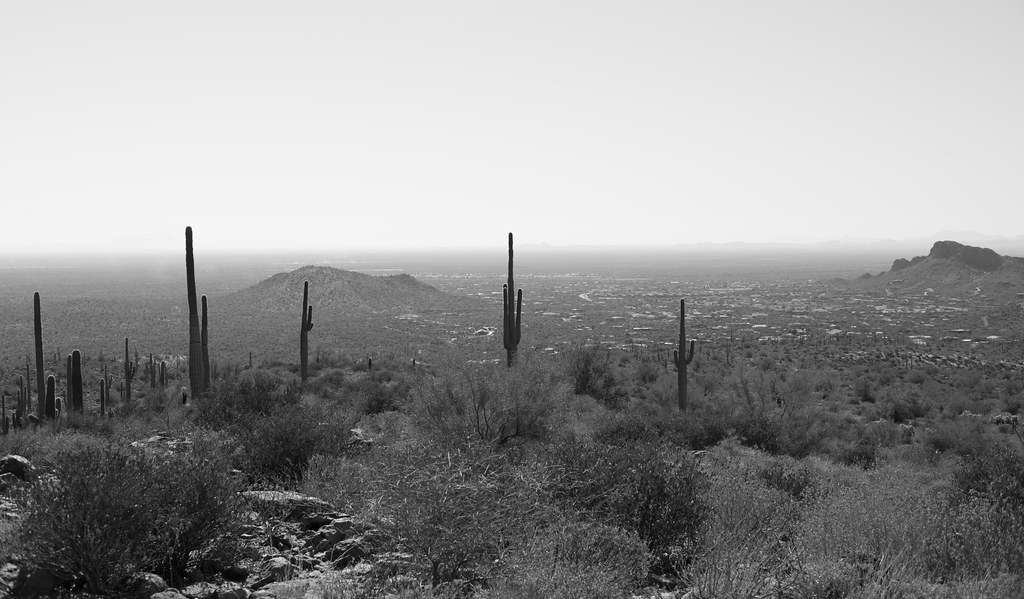
A journey to Shadow Belmont
Welcome to Shadow Belmont. A place deeply familiar with shade. Shade architecture, shaded transport, sheltered time. A cityscape layered with a latticework of porches, pergolas, verandas, galleries, awnings, canopies, umbrellas and trees. From above the city is mirage-like as a desert garden. The shade of high canopy covering cactimorphic succulent pillars, doubling as public water sources. Closer to the ground, multi-trunked mesquite marquees diffuse light across outdoor kitchens and intimate courtyards. The ubiquitous antennae of the place mingle with soaring ocotillo vines, their cabling protected by dessicated saguaro skeletons. Solar-powered screens radiate the shadow forecast and predict a cooling breeze. The STA (Shade Traversal Association) maps show real-time developments, with roads in direct sun coloured flaming red. The droning of traffic blends into the murmur of slowly adjusting structures finding and creating shade. The continuous background hum of insects, psychic noise and ambient communication.
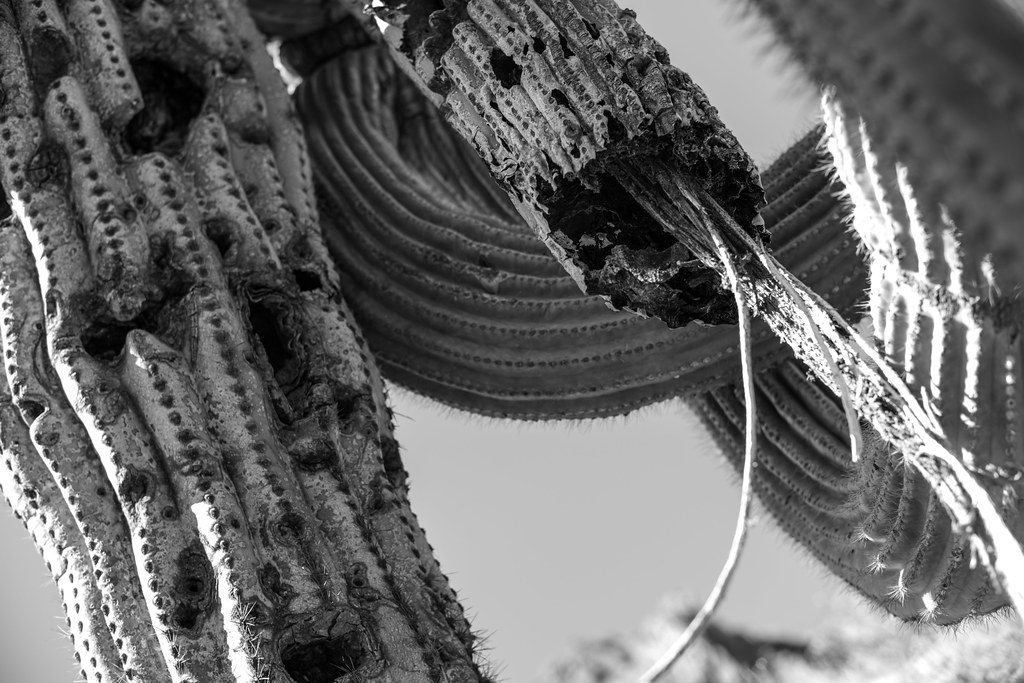
This is a city enfolded in the long temporality of the desert. It abides in time marked by feasts and silences. A world capable of sudden bursts of ecstatic action, like blooms after a desert rain. As all activity eventually ceases, idleness is embraced, one of many techniques to attune to the desert. A city in a city living the experiential time of spiders, snakes and saguaro. The variable abundance of time is sensed and modulated by an antennae-centric tech industry. Deep listening technologies. Nomad tech on smart grids accustomed to oscillations of resources. People and technology attuned to differentials and committed to the act. From independence to interdependence. From individual bodies to communal infrastructure, the city is continuously aligning with its changing conditions. A gradual redesign. From behavioural change to contorted comportment.
This place does not shy away from its own shadow. The shadows of dust storms, water shortages, gun-slinging individualism, heat delirium and venomous critters, the fickleness of the desert and its inhospitable heart. People congregate under urban canopies. Their senses augmented with panpsychic technologies, they hear those Who Shall Not Be Named. Those who speak in heterogeneous voices. The nameless dust clouds and rocky outcrops, the social insects in their frantic mounds. The shy reptilian monsters and passive-aggressive chollas. The gloomy spirits of cell towers and brooding pygmy owls. In shady saloons cowboy hermeneuts channel messages from barren lands. They conscript guileless snowbirds for expeditions into the shadow world. Occult sciences, fictocriticism, and dust theory are common fields of study. Entrepreneurial alchemists embrace the long process of transforming zombie-utopias into compost for regenerative heterotopias.
The political and economic thaumaturges divide their energies between experimenting with hybrid governance structures and fighting shadowy battles for dominance of the three pillars; market, government and commons. Shadow Belmont is plagued by regular skirmishes between hard-line libertarians, and the more convivial cryptoanarchists. Meanwhile, the autonomous shadow courts are sentencing property fundamentalists to shade growth, under the watchful eye of the IRS (Internal Review of Shade). “In Shade We Trust!”
In transition, the government functions as a medium between humans and other entities in the district. Water, with all it’s power, is treated as a nonaligned political entity in its own right. The shadow minister of translocal affairs advocates “the social responsibility of a coven” and inclusion of an act for the rights of “diverse states of matter” in her inaugural speech. With drought cycles lengthening, water tokens fluctuating and heat waves becoming less predictable, self-reliance is gradually finding a place alongside the security of intergenerational commons management and stewarding the preciousness of life, in a desert teeming with life.
List 3
- A Practical Guide to Unconscious Reasoning
- Into the universe of technical images
- Panpsychism & Noumenautics
- The word for world is forest
- How forests think
- Q is for Quicken
- Point Omega
- Ventus
- Finite media
- Crystal radio
- Geology of media
- Romantic machine
And then it was time to depart. We run through the usual routine of packing and cleaning. Everything is dusty. As if the desert is clinging onto us as we take our leave. Months later we’ll still find its particles mingling with dust from elsewhere on our boots. Dust of places ground in the mill of time. Places that remain lodged in the alveoli of our lungs and the warm caverns of our hearts.

Dust and shadow. Fieldnotes #3
Sonoran & Great Basin Deserts 020180304 to 020180330

“The true alien recedes interminably even as it surrounds us completely. It is not hidden in the darkness of the outer cosmos or in the deep-sea shelf but in plain sight, everywhere, in everything. Mountain summits and gypsum beds, chile roasters and buckshot, microprocessors and ROM chips can no more communicate with us and one another than can [an] extraterrestrial. It is an instructive and humbling sign. Speculative realism really does require speculation: benighted meandering in an exotic world of utterly incomprehensible objects. Ian Bogost, Alien Phenomenology
We landed at the Sky Harbour around midnight. After a dazed stumble through the near deserted airport we found ourselves in a dark, semi-covered street, smelling of fuel and stale exhaust fumes. Deep shadows lingering in the air speckled with particulate dust. Distant sounds of unseen critters, in a desert marked by stark contrasts between heat and chill, adoration and dread, escape and extraction.
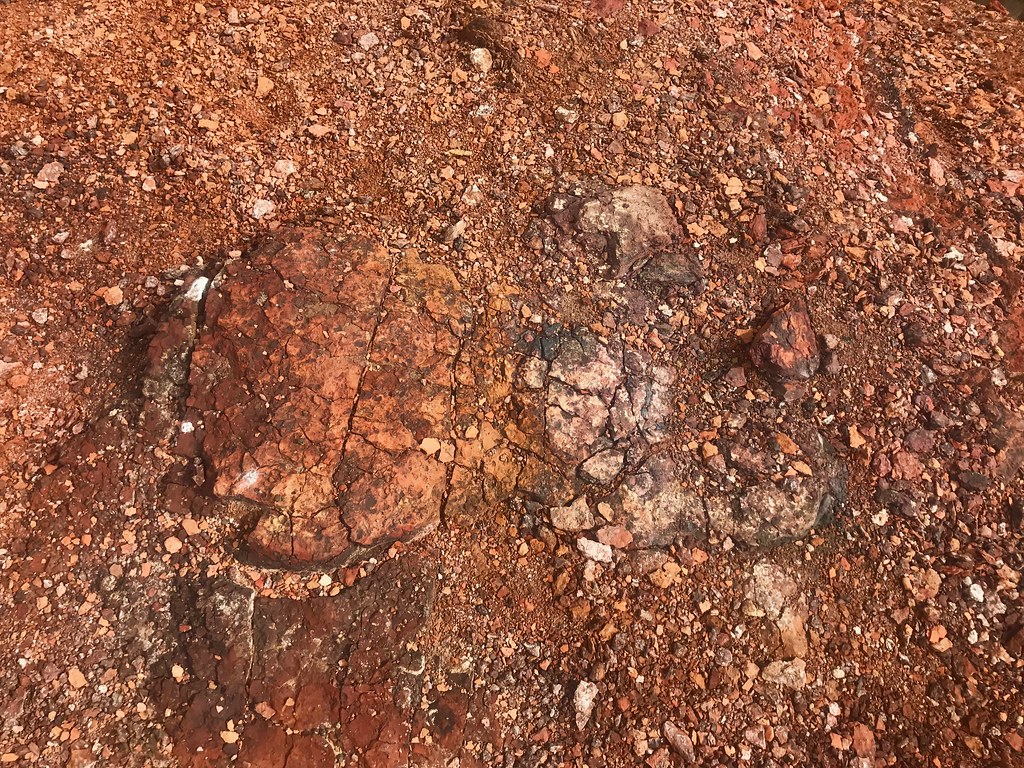
Desert Attunement
Our gradual attunement to the desert expanse, its climate, rhythms and scales became an experiment in communing rather than examining. An exploration of an embodied sense of layered time and material wonder. Being part of the world without romanticising wilderness or drawing hard distinctions between the desert and the cities within it. And so we embarked on that most archetypal of American experiences, The Road Trip. Attunement to the surfaces of the desert at the pace of modernity. Atypically, in a small (by local standards) hybrid car.
An attunement at various speeds and human densities. Attuning to the smear of the landscape sliding past while driving, to the irregularities of the path while trail-running or hiking, to the sounds of the frosty ground and howling wind while walking. Along the Path of Time, where each step marks one million years. Down beyond the rim of the Grand Canyon, its scale overwhelming physically and perceptually, joining the intrepid 3% of visitors who dare leaving the comfort of buses and paved paths. We would stop and listen. Seek out faceted moments of geomediation at the Hermits Rest, after staring down The Abyss. Layers upon layers, Bright Angel Shale, Vishnu Schist and Zoroaster Granite. The Great Unconformity (an absence, a non-layer). The desert chirped and rattled and murmured, punctuated every few minutes by the roar of an airplane overhead, buffeting the chatter of birds, cracking of wood, or an argument between unseen humans. The effortless, unperturbed, lithic existence of the planet present in its apparent stillness.
Here is the Stillness, which is not still even on a good day. Now it ripples, reverberates, in cataclysm. Now there is a line, roughly east-west and too straight, almost neat in its manifest unnaturalness, spanning the girth of the land’s equator. (…) The line is deep and raw, a cut to the quick of the planet. Magma wells in its wake, fresh and glowing red. The earth is good at healing itself. This wound will scab over quickly in geologic terms, and then the cleansing ocean will follow its lie to bisect Stillness into two lands. Until this happens, however, the wound will fester with not only heat but gas and gritty, dark ash — enough to choke off the sky across most of the Stillness’s face within a few weeks. Plants everywhere will die, and the animals that depend on them will starve, and the animals that eat those will starve. Winter will come early, and hard, and it will last a long, long time. It will end, of course, like every winter does, and then the world will return to its old self. Eventually. (…) Eventually meaning in this case in a few thousand years. N.K. Jemisin, The Fifth Season
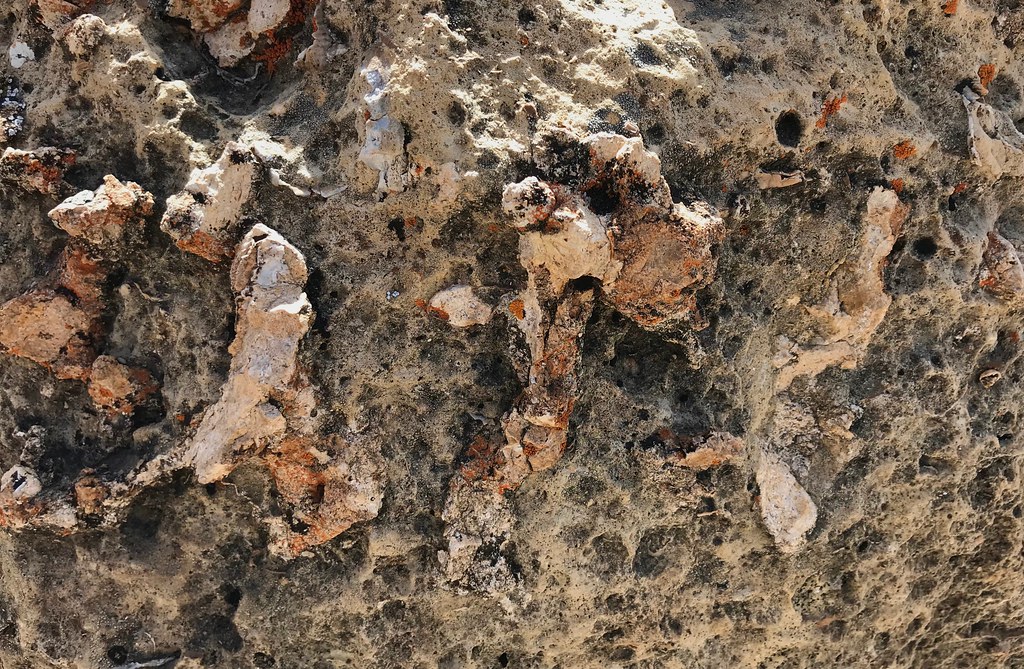
The spatial and temporal scales in the desert show themselves differently when experienced at speed. Driving through canyon country becomes a movie of geological magnitude. What began as a pale green plateau covered with the shy budding of early spring splits into dark jagged lines. A crack in the earth. The crack widens into a gorge and deepens into ravines. It splits open the landscape until the horizontal plateau disappears into the vertical crags of raw rock face. Geological scar-tissue as monument to the violent, persistent forces shaping the earth. Echoes of an era before the planet became hospitable to humans. Reminders not to take the Earth’s hospitality for granted.
A few hours (or moments) later time is adrift, scattered, discarded as it blows erratically along the roadside. The highway turns north into the Painted Desert. We glide through a gentler geological process — layered sedimentation of rock and sand and ash. Reds, pinks, yellows, purples interspersed with gradients of dusty grey, black and white. The dust of minerals layered with the dust of forests and crushed bones. From afar the hills appear liquid, coloured with inks and turbulent water. We drive through time-scales in which rocks behave like fluids. Layered time of fossilised erosion. What might the thin layer of the Anthropocene look like, when sedimented atop those older layers, with hues of non-compostable plastics and industrial waste? What layers will come next? What will cover the remnants of the human-dominated sliver of deep geological time?
The parking lot near Horseshoe Bend was busy enough for time’s acceleration to the speed of gnats and twitching selfie sticks. We found ourselves in the wake of a Japanese hip-hop band, trailed by cosplay girls, followers in full regalia, teetering on the cliff edge in dainty high heels. Photogenic humans photographing themselves in photogenic topography. Attuning to digital mediation of landscapes framed at screen resolution. No drones allowed. We were attuning to an Insta-desert in which moments of awe are carefully mediated. The experience validated by small screens and prescribed perspectives.

In front of the legendary Antelope Canyon, our Navajo guide warned us that this is a spiritual place, where no-one (except flood water) should enter. Yet she ushered us in. Uncanny shafts of light framed by smooth undulating rocks guided our gaze as we scuffled along in hazy shadows. Thick drifts of dust stirred up by thousands of feet. The perspective changed with occasional flickers of iron-ore coloured light, opening upwards into cavernous formations. Looking up, we could have been in the womb of the planet, all red and warm and smooth. Looking around, reds turned into dusty browns, pinks and ochres of human faces. Some bewildered, some quietly overwhelmed, others indifferent and impatient. A complicated tangle of humans cramped between unyielding rocks, compressed into the slotted time of a tour, rubbing shoulders with those who came before and after us. An attunement to the rhythms of desert tourism.
Since a thing cannot be known directly or totally, one can only attune to it, with greater or lesser degrees of intimacy. This is not a “merely” aesthetic approach to a basically blank extensional substance. Since appearance can’t be peeled decisively from the reality of a thing, attunement is a living, dynamic relation with another being. Timothy Morton, Attune (in Veer Ecology)
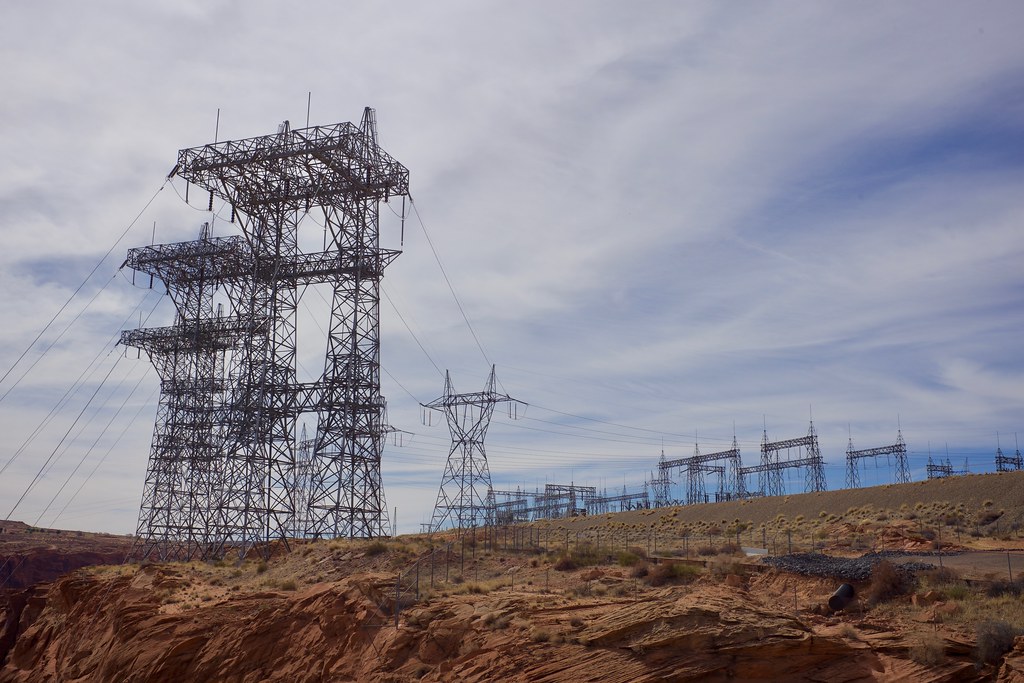
Squeezed into the back of a truck, we trundled past the Navajo Generating Station, a massive 2400 MW coal power plant whose imposing structure rises from lands leased by the LeChee Chapter of the Navajo Nation. Its smokestacks and powerlines deeply embroiled with the desert. Salient signposts of dark histories, a complicated present and difficult futures.
On our way out of Page we crossed the modernist megalith of the Glen Canyon Dam, a solid promise of progress with scant regard for any detrimental side-effects. We stopped, listened, documented. This too belonging to desert attunement in the Anthropocene.

In the roadside Rock Shop, near Orderville in southern Utah, ancient minerals are broken into chunks, shards and pebbles, sold by weight, colour and size. We couldn’t resist stopping to marvel at the colours and textures laid bare in the bright sunlight. Obsidian, septarian, copper ore, bloodstone, sodalite, desert rose, amethyst geodes. Buying slivers and shavings of the Earth’s raw flesh from a geological butcher, wholesale.
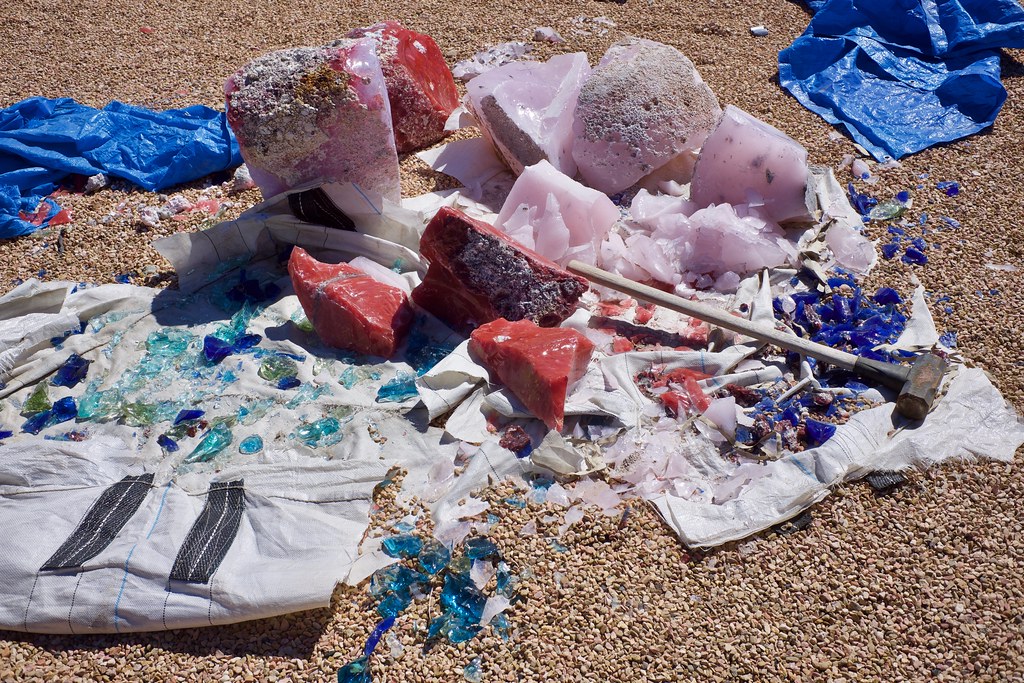
We drove further north, to the edge of the desert. Bryce Canyon on the semi-arid Paunsagunt Plateau shares more with Scandinavian or alpine biotopes than what we had previously seen in the deserts of the Southwest. We were greeted by snow, gnarly pine trees and crisp mountain air, contrasting with the pink and orange hues of the mysterious hoodoos. These ancient eroded rock formations extend throughout several natural amphitheatres like the stuff of myths. Hiking trails named “Queens Garden” or the “Fairyland Loop” encourage childlike fantasies and an easy anthropomorphising of the landscape. According to indigenous Paiute mythology, the hoodoos are remnants of greedy To-when-an-ung-wa, the Legend People turned to stone by the trickster god Coyote. A monstrous work of land-art cautioning against “living too heavily upon the land”.

Through the bodies of the Legend People, with mud and snow sticking to our shoes we slid and slipped towards an empty riverbed, holding onto gnarly bristlecone pines. Their bark twisted and turned around the trunks, textured in convoluted alien scripture and secure handholds. Above our heads the wind played the needles and dry branches. To these otherworldly instruments we added a rhythm section, crunching frost and squelching sludge under our feet.

At the bottom of the trail, the wind stopped. Silence began creeping back into an already sparse soundscape. A drop of water. A solitary crow. A tiny crack or slide of a sleepy mountain. And then, the inevitable noise of humanity returned. The loud voices of jets. Trail runners. A particularly asthmatic motorbike in the distance soloing above the spluttering orchestra of ringtones and notifications. The invisible smog of noise pollution hovering over the still places, cloudlike.
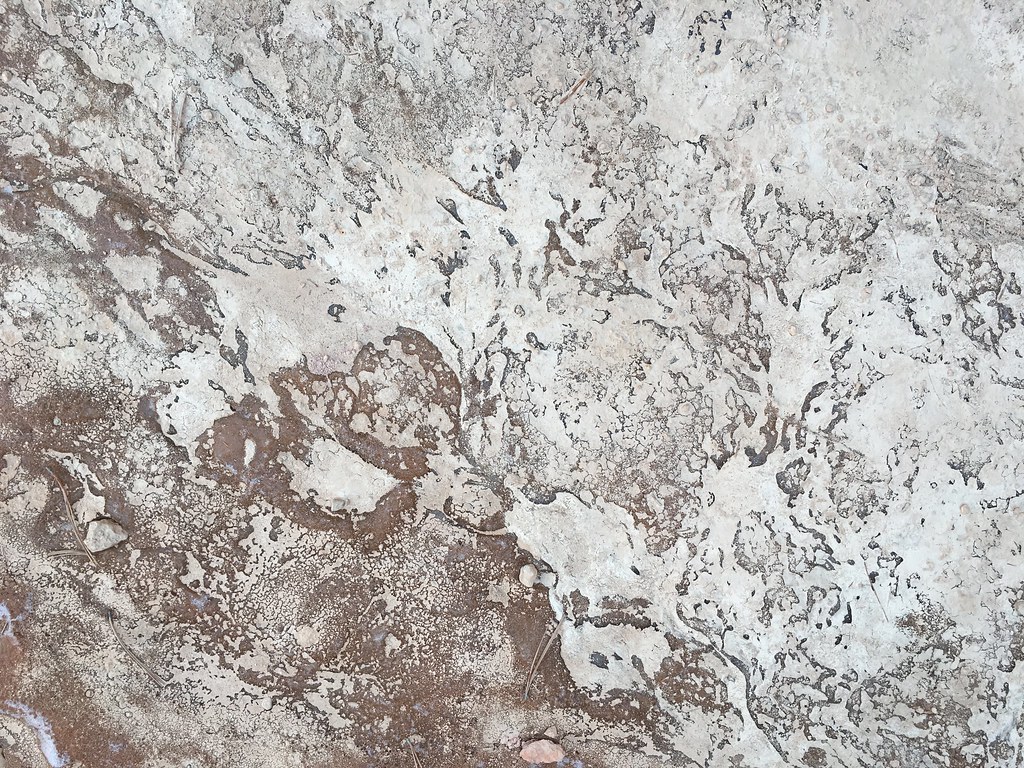
We travelled onwards as clouds loomed on the horizon. Storm clouds. Dust clouds. Clouds of invisible pollution. What appeared as pristine desert could harbour an atmosphere filled with airborne toxic dust and deadly ground water. We followed clues from the Center for Land Use Interpretation, driving through Tuba City, a town known for its uranium mill from 1956 to 1966. The scars both visibly and invisibly remain.
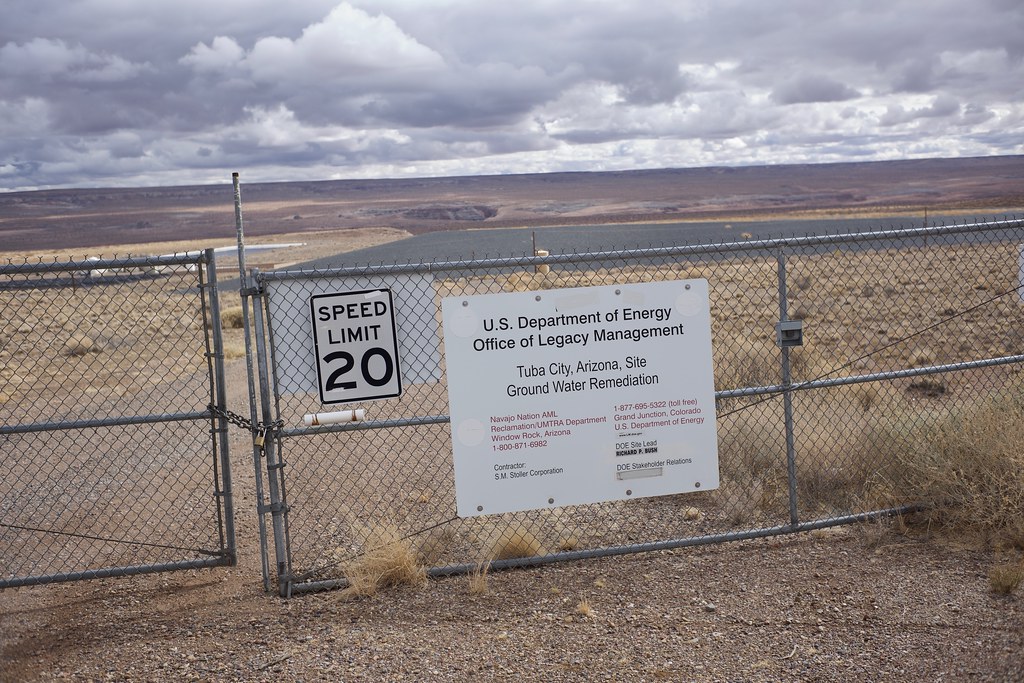
Attuning to this landscape gave rise to a visceral sense of unease, displacement, halting conversations, prolonged awkward silences and the hollow taste of unseen dread, skewed injustices.
Tuba City Uranium disposal cell
Just outside the town we found the Uranium Disposal Cell. Framed by barbed wire and DOE warning signs, the Cell is a hermetic dull scar, far from the spectacle of “Atomic City” (neither Las Vegas nor Los Alamos nor Midway), uniformly dark grey and rectangular cut into an amorphous arid plateau, geometrically attempting to outlast the half-life of uranium. An eerie regularity, in stark contrast to the nearby Coalmine Canyon, whose contours continue to change over time, sculpted by erosion into gracefully intricate carvings. The blacks, reds, yellows and whites extending into the depths beyond sight. A temple of lithic giants under a brooding sky. Worshipped by flocks of crows and the occasional human.
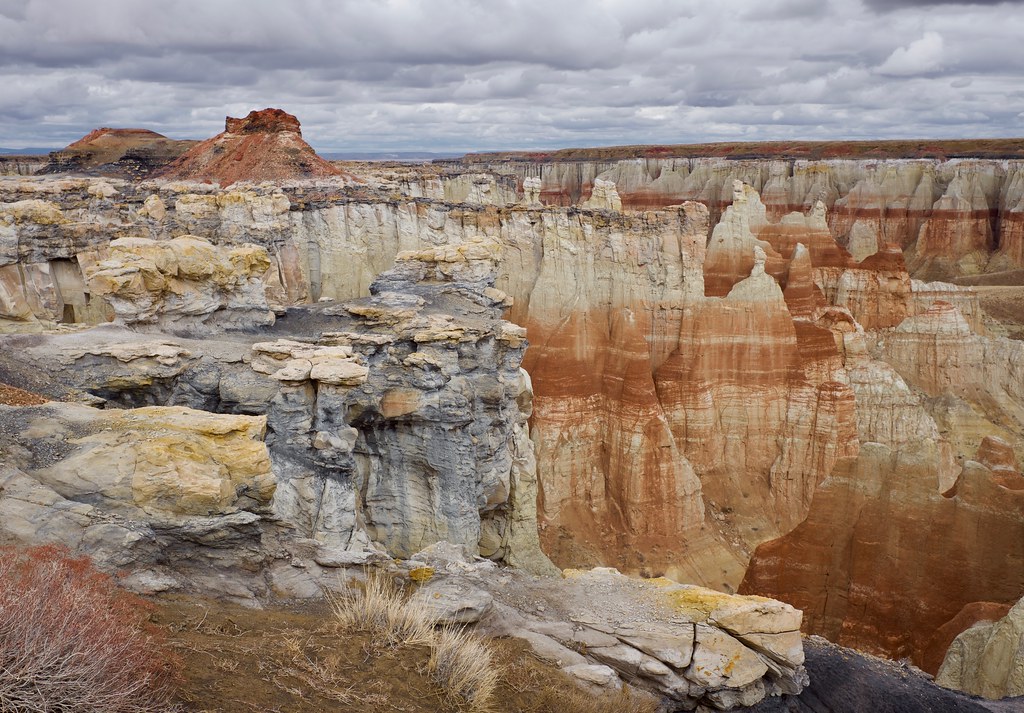
It is not enough to fight for the land; it is even more important to enjoy it. While you can. While it’s still here. So get out there and hunt and fish and mess around with your friends, ramble out yonder and explore the forests, climb the mountains, bag the peaks, run the rivers, breathe deep of that yet sweet and lucid air, sit quietly for a while and contemplate the precious stillness, the lovely, mysterious, and awesome space. Edward Abbey
Dark clouds had covered the sky completely as we began the slow descent from the Colorado plateau. We followed miles of power lines and fences, occasional churches emerging from the mirage of an endless road. No Sunset Crater, no Marble Canyon and no condors. No dusk recordings. Instead, the highway framed in icy rain lead us to the creature comforts of Flagstaff. The historic Monte Vista hotel celebrating its famous guests alongside ghost stories and disturbances (when John Wayne met The Phantom Bellboy). Craft beer and pizza. Motion sickness pills and “The Broken Earth”.
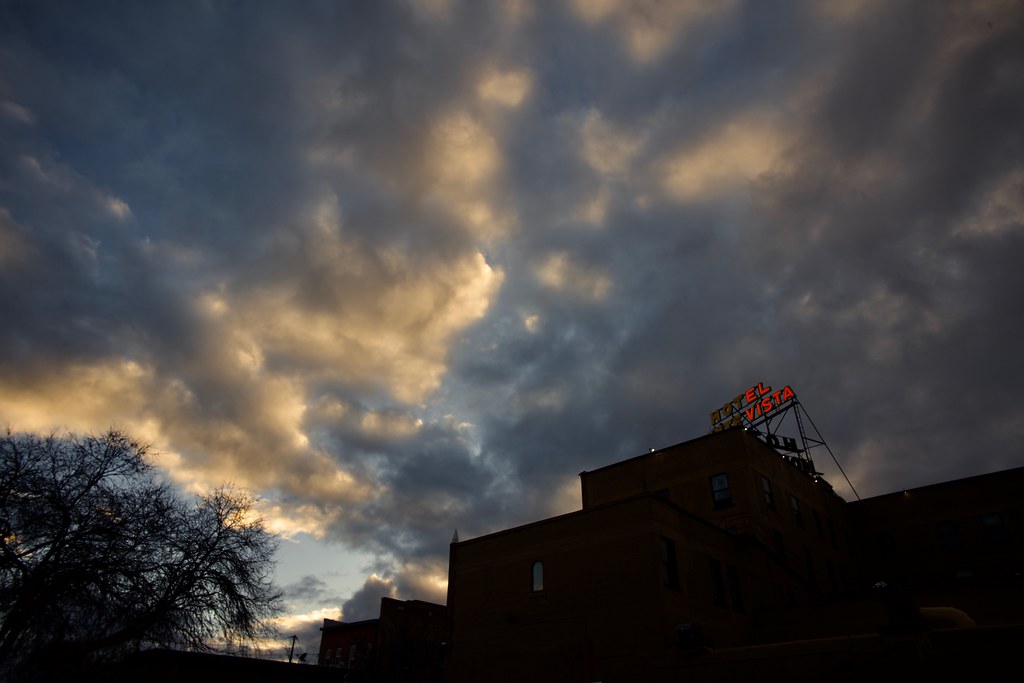
A temporary listening station
The next morning, as we returned to saguaro country, the clouds parted and temperature rose. We continued our deceleration from 5000 miles in a day, 1000 miles in a week to one mile in 10 days. We arrived and we stayed put. We listened. Experiencing the desert at 0mph, as the warm light of the afternoon intensified into a blood-hued sunset, then faded into cool shades of dusk, until the pinprick starlights began blinking into existence, scattered across the desert sky.
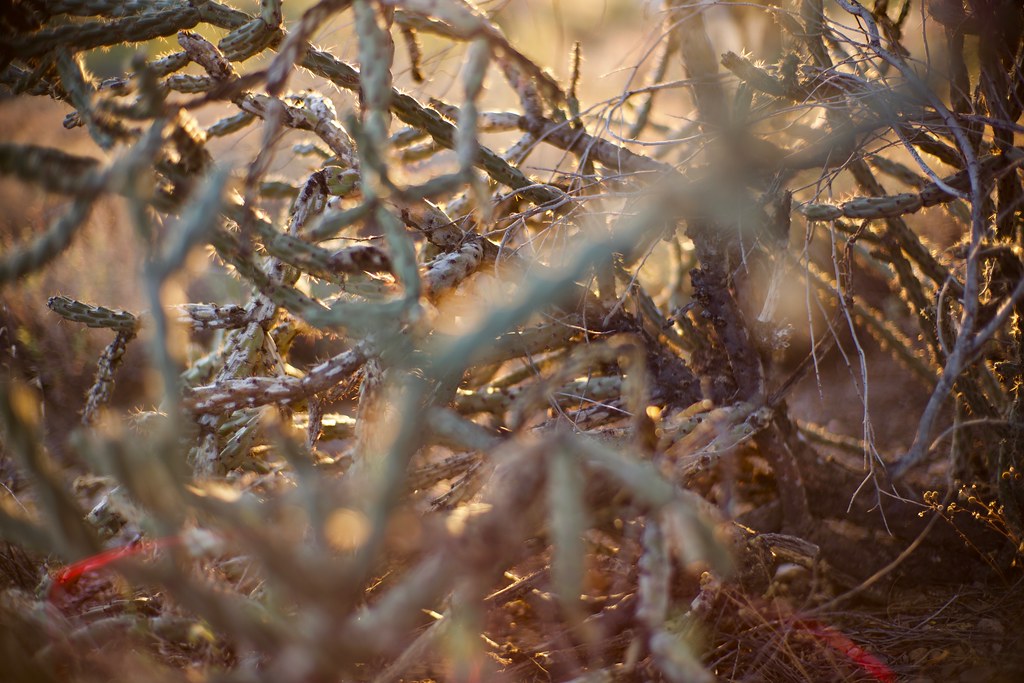
The longer we remained still, the more frequently our neighbours visited. Humming birds, lizards, insects, crows, a pack of coyotes, deer, javelina, even a solitary shapeshifter. The nocturnal scuttlings of unseen beasts. The brutal nonchalance of bats eating crickets. A mundane spectacle of the everyday, indifferent to our arrival. Amidst this teeming habitat on the edge of urbanity, we began eavesdropping on the incomprehensible conversations of animate matter. Dust and cacti, trees and insects, concrete and sunlight. What could their voices tell us about the place? What technologies could provide a way of communicating (or communing) within the narrow band of human awareness? What would those technologies look like that could help us attune to our surroundings, rather than distracting us from them? How could we help ourselves listen to the entities we share the planet with?

[Gordon Hempton] discovered that the use of a microphone turned him into a better listener, because he learned to take his cue from that tool, which didn’t judge the relative value of the different sounds it was absorbing. Having always in the past striven to listen for the “important” sounds, Hempton stopped trying to prioritize based on his own limited perspective and discovered the majesty of the uncurated soundscape. George Prochnik, Silence
We unpacked our machinic assistants and spent several days listening to the desert as our ears adjusted and a range of microphones, headphones and speakers widened the scope. We began to learn the subtle variations in daily routines of plants and animals. We explored the sonic textures of cacti, palo verde trees and creosote bushes, listening to the wind on their skin and caressing surfaces with sensing devices. We experimented with directional and ambient recordings, deliberate and incidental sounds. The Saguaro, the dawn chorus, omnipresent engines, and the occasional droning of military helicopters in urban training exercises. Woodpeckers playing metal chimneys, thrashers mimicking police sirens, howling conversations between dogs and coyotes at dusk. Above and through it all, vast geological scales cast their long shadows, imposing a silent, harsh indifference.
As our technologies became conversation partners, we summoned entities from software realms, to interpret, translate, juxtapose and convolve the many overlapping voices. We began to hear new patterns emerge, cut through by fictocritical yarns woven by our human guests. Our composition emerging from impressions of this urban desert as it is and as it might be, from multiple perspectives and with many voices heard, but not necessarily understood. Over time the sounds emanating from the computers blended into the sounds outdoors and the embryonic compositions in our heads. The voices of the desert haunted us, following us through both waking and dreaming worlds.Dwelling in a building that blended into its environment drew us further in.
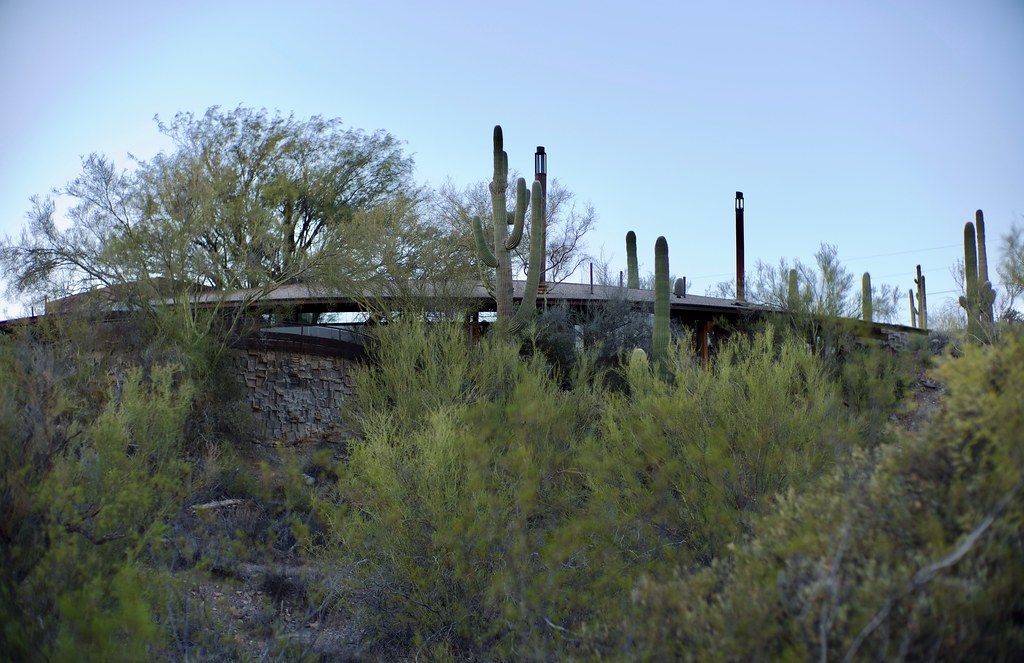
Our buildings are designed from the outside in and the inside out such that their form is a reflection of spaces within and never just form for form’s sake. An authenticity of material choices and rigorous detail resolution carry the logic of ‘making’ and provide a weighted connectedness to place (…) [A]ll our senses are alerted and nourished. Our curiosity is piqued, our time and place is reflected and respected in unexpected ways. Our minds are opened to new ideas, our confidence in the possibility of the human endeavour renewed. We feel comfortable yet challenged, understood yet urged to stretch. We want to be in such places alone and together with others. (…) We want such places to serve as markers of our best efforts. We want such places to exist beyond our lifetime. Will Bruder Architects
Such places entwine human and environmental energies into a home. A home that lends itself to deep work and solitary reflection as much as to convivial gatherings. Tables filled with seeds, herbs, grains and flowers. Pinyon pine nuts, chia seeds, amaranth, sumac, sunflower seeds, corn and mesquite flour. Agave and aloe vera juice. Mezcal, pulque, tequila. A Dionysian feast heralding the season of flowering cacti and renewed growth. Meandering alongside cholla buds, nopalitos, yucca, ocotillo and palo verde flowers. A celebration of the vernal equinox, at a time when light and darkness, the mundane and the sacred are equipoised. A time for alignment and attunement. As we attuned to the vigour of spring, the frosty thorns of winter were ritually banished with scented smoke and resonant words…

On a tiny staircase connecting the circular Kiva with the desert, stood an abandoned statue of Kokopelli, the trickster god of fertility, agriculture and music. An auspicious coincidence. We placed two bowls in offering. One bowl of water and one bowl of creosote branches. When moistened, the oils in the rough creosote leaves emit a scent reminiscent of the desert. Dry, bitter and pungent. A scent announcing the season of replenishment and renewal.
Action on behalf of life transforms. Because the relationship between self and the world is reciprocal, it is not a question of first getting enlightened or saved and then acting. As we work to heal the earth, the earth heals us. Robin Wall Kimerer, Braiding Sweetgrass

By living on the edge between the desert and the city built within it, our workflow gradually attuned to the rhythm of our temporary habitat. We’d wake up before dawn, together with the chorus of wildlife and motorised vehicles. Sunrise would bring about a marked sense of acceleration, in response to the intensifying light and temperature. Our work flowed alongside insects and birds busying themselves with their daily chores, until mid afternoon. Then everything and everyone around us seemed to decelerate. We followed the example of the reptiles lazing atop scorching rocks and would take a break during the hottest part of the day. As the sun began its descent, the pace would pick up again, in and around us. We worked in a state of productive flow, characterised by concentration and deep absorption, whether we were designing, composing, programming, cooking or writing. After dusk, the diurnal critters exchanged places with the nocturnal ones, air traffic lessened and we’d drift from productive to reflective, until the hushed atmosphere of the night encouraged sleep.
Shifting Gears
With the experiments in desert attunement our creative process began to merge with the spatial and temporal qualities of the surroundings. A strong aesthetic resonance with the organic architecture of our workspace and the shimmer of the landscape. Yet the sense of being surrounded by boundless desert was an illusion. Our attempts to walk further than a few minutes in any direction were soon hindered by visible and invisible fences. There are few traces of walking here. The only suggestions of habitation were traffic noise, warning signs and the occasional flashes of light reflected off distant surfaces. A place of beauty devoid of human contact.
[Andrew Ross] warns of an “eco-apartheid”, whereby low-income neighbourhoods on the more polluted south side of the Salt River (which once flowed vigorously through the city and is now a trickle) are less able to protect themselves from the heat and drought than wealthier citizens. “There’s a stark disparity,” he says. “The resource havens, with their hybrid cars, their solar panels and other green gizmos; and the folks on the other side struggling to breathe clean air and drink uncontaminated water. It’s a prediction of where the world is headed. Joanna Walters, Plight of Phoenix: how long can the world’s ‘least sustainable’ city survive?
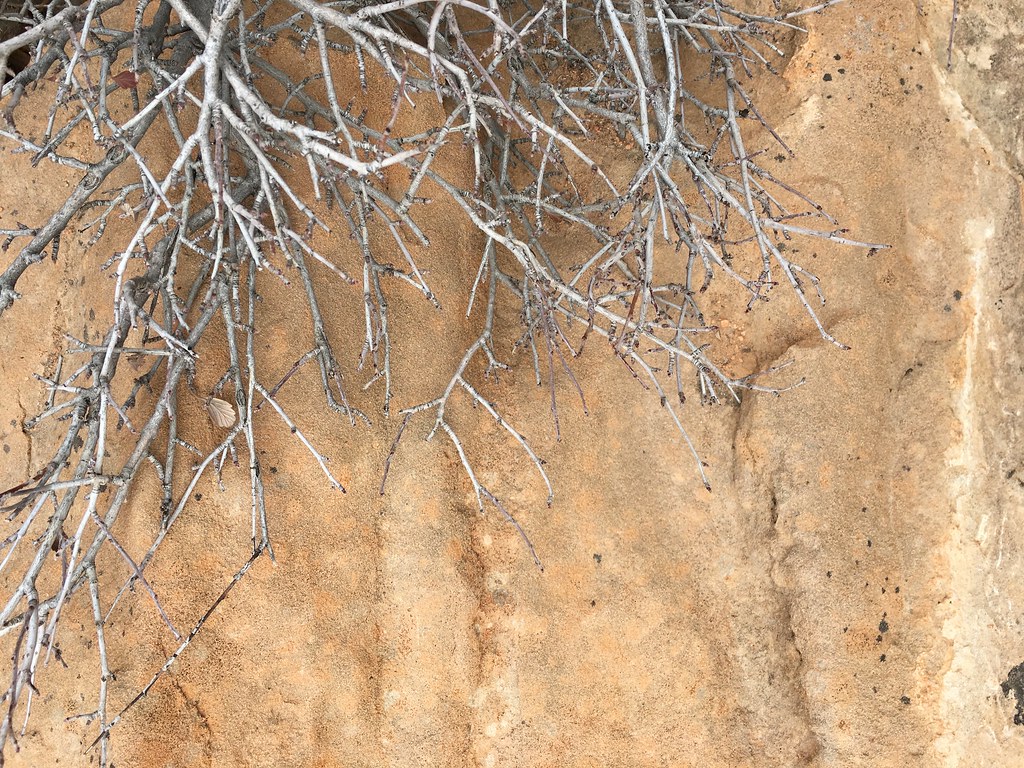
Back in Phoenix. Within minutes of our arrival we were attuning to time dictated by business hours rather than cycles of daylight. Time as a commodity. Linear time, always slipping into the past or the future, just out of reach. Beyond false refuges of partial attention, rapid context switching and chronic busyness. A visceral sensation of running out of time. Restlessness. Numbness. Hyperactive anxiety. A psychosomatic turbulence leaving heartfelt aspirations in its wake.
Our daily rhythm became halting. Stopping and starting. Living between stochastic changing of gears in intermittent traffic jams. Time was scarce, yet space appeared abundant. Commuting could easily devour hours from each day, across an urban landscape extending for miles in a relentless sprawl of city, suburbs, exurbs. Cars remain a dominant feature of the landscape, motile architectures gradually transforming desert environs.

From the vantage point of air-conditioned motorised vehicles the environmental and social change seem distant, or even nonexistent. Yet when we stepped out and walked, we noticed small but promising pockets of change, growing like persistent weeds through the cracks in the pavement. Collectives and co-operatives working to transform their neighbourhoods one lot at a time. We walked through downtown Phoenix, across Tempe campus, through farmers markets and desert parks, along black shimmering asphalt and tree lined side streets. While walking, the rigid layout of the urban grid is occasionally softened by unexpected encounters. The warmth of human contact rekindled by acknowledging each others’ presence. An occasional smile, a simple compliment, or even a mumbled apology when inadvertently bumping into a fellow walker would re-establish a sense of conviviality.
Meanwhile, on another street in Tempe, “An Uber self-driving car hit and killed a woman crossing the street […] marking the first fatality involving an autonomous vehicle and a potential blow to the technology expected to transform transportation.” (Reuters)
What ensued was a predictable mix of outrage and the sounds of a corporation distancing itself from responsibility. The opinion machine cranked into action. Blame was thrown around casually, solutions were promised, tests suspended, technological progress was declared inevitable. A clear pharmakon, with technology in an ambiguous simultaneity of problem, solution and scapegoat. Yet the doubts remained. Doubts about possible futures and the disjointed present, the urgency of significant change and the disproportionate insignificance of action.
Elaine Herzberg became the first pedestrian killed by a self-driving car, joining other women remembered primarily for their misfortune at the mercy of machines. In particular, Bridget Driscoll, the first recorded death of a pedestrian caused by an automobile in 1896 and Mary Ward, possibly the first fatality caused by a motor vehicle in 1869. While these women may be remembered as victims, there extends a mass of anonymous urban walkers (and other n-peds), plants, lands, microorganisms and macroscapes who continue to be sacrificed on the altar of speed. Yet Phoenix is also home to the unique Museum of Walking (MoW), “committed to people, land, action, and site through the everyday act of walking”.

In cities built around cars, walking can feel like an act of resistance or an act of hope. Purposeful walking and aimless wandering alike. So, as guests of the MoW, we invited the local inhabitants for a walk. A soundwalk, a form of contemporary geomancy. A pretext to re-discover aspects of their home and glimpse alternatives that might not have been visible otherwise. An embodied reading of the landscape as it is and as it could be. Worldwalking, worldknowing and worldbuilding together. Accompanied by the constant hum of cars and insects, beneath a busy flight path.
We crossed the threshold into the Moeur Park, a dim tunnel under a busy highway, decelerated, listening. The soundscape was subsumed into the deep drone of traffic. Walking slowly, in single file. Waiting for each step to find its footing, as the senses become engaged with traversing inner and outer landscapes, simultaneously. We traced the edges of the city and the desert, attuning to their complex rhythms and relationships. Rhythms above and below, sharp interludes. Along a path beset by the spectre of an abandoned railroad, hollow and dusty. Snaking along a resonant ridge haunted by jet engines in the wind. Climbing through an outcrop of boulders, hearing the rustling of sparse undergrowth. Aswarm with critters signalling. Absorbing the desert expanse at dusk, in The Silence of the Cacti. A gentle turn revealing urban soundscapes of civilisation in collapse. Hushed darkness cut through the eerie river of tail-lights. A descent, into the dripping, budding and chirping of early spring. The hollow dryness of a rustling desert, gradually receding into the night with unseen others, uncanny and quiet. We let our minds wander, spinning new yarns, possible lives lived otherwise. Of vapour trails writing their poetry in the colours of sunset.
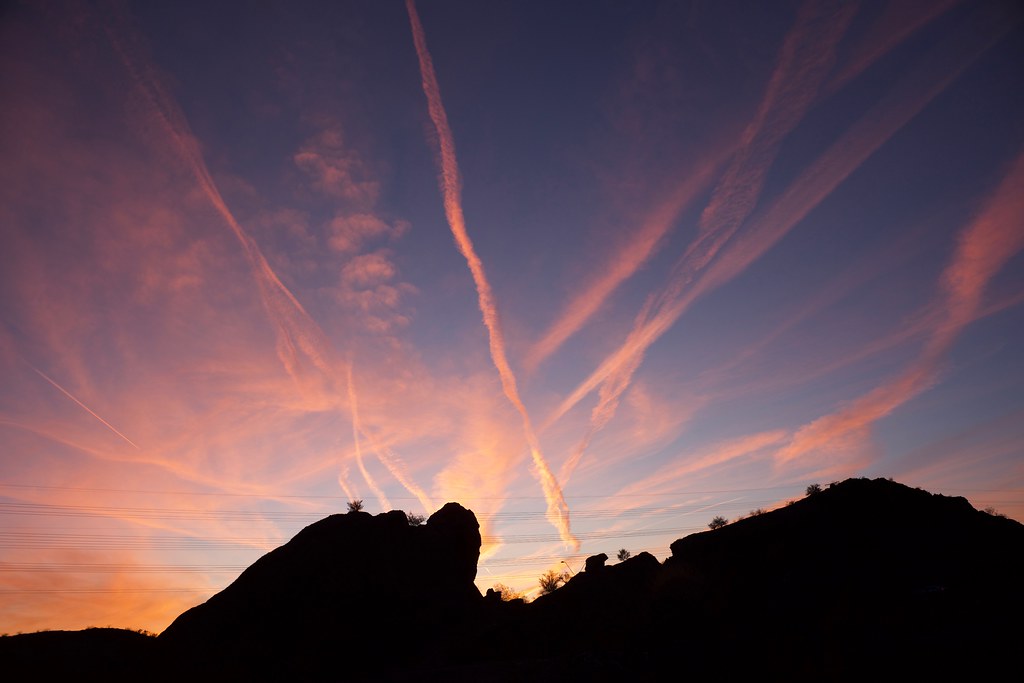
Afterword
By Adam Nocek & Stacey Moran on behalf of The Center for Philosophical Technologies
Dust and Shadow was mythological from the beginning. Stories wrapped in stories, wrapped in ever more stories. Stories we told about the scope of the project, about its relevance for thinking sustainable futures in the desert southwest. Stories we told ourselves about what the project was really about, establishing critical and speculative distance from technocratic solutionism and business-as-usual. There were stories we constructed about how we could work together as Professors, nomadic practitioners and activists. And there were always stories about how it was going to end. How do we conclude this story? Or do we? Maybe it continues or maybe it ends right where it began: in search of old and new myths.
The Center for Philosophical Technologies has its own story about Dust & Shadow of course. In our version, the project began during a family residency with FoAM in Brussels. There, we began asking questions about how to transform animism and other non-modern practices into a praxeology for the contemporary world. These questions were in many ways at the core of the Laboratory for Critical Technics, which morphed into The Center for Philosophical Technologies (CPT) in 2018.
How might we transform philosophy into a technics for thinking-feeling-practicing otherwise? And what could be in more need of this philosophical technicity than a sprawling urban center in the middle of the desert? Our Field Marshal, Ron Broglio, was the missing link. He made it possible to work with FoAM in the desert and to begin crafting technics for living and dwelling otherwise.
Paul Ricouer once noted in an interview that there is an “imaginary nucleus” at the center of every culture, and this nucleus is the culture’s “opaque kernel” that exceeds all self-understanding and is irreducible to any set of “explicit functions—political, economic legal, etc” (Ricoeur and Kearney, “Dialogue With Paul Ricoeur,” 236). It is only when we “try to grasp that kernel,” Ricoeur explains, “that we may discover the foundational mytho-poetic nucleus of a society” (239).
What became readily apparent to us, as we researched the urban desert, as we listened to it, and as we tried to make sense of its many contradictory elements, is that the mythical nucleus upon which its neoliberal and technocratic logics are built needed a redesign. We need new myths. We need new stories upon which to build and redirect our practices.
But how do we go about this? How do we rewrite the stories of progress, development, and competition that we have inherited and so easily reproduce? We knew that our myths could function as antidotes to the stories poisoning our relation to the desert for so many generations. They should also be attentive to indigenous ways of knowing and being-with the desert. Our counter-mythology would be an amulet capable of protecting us from the many seductive, yet treacherous sustainability narratives. Our design work appeared more like witchcraft than any recognizable human-centered approach to sustainability design. It had to be carefully staged and lurk in the shadows.
Our desert laboratory doubled as a secret lair for occult practices where stories and rituals for parallel technologies, gnostic healing, and mystical pedagogy could be woven. The first experiments or spells cast would redirect human attention toward the many layers of sonic experience. Their effects are just beginning to take hold. If a soundwalk and album look like recognizable outcomes, then this is a good thing: the amulet worked.
We see Dust & Shadow as one of many ongoing attempts to pry open the cracks in our cultural imaginary and craft propositions for protection, healing, and thriving in a world that is in dire need of more shadowy practices.
Bibliography
see bibliography
Credits & Colophon
Text, image and book design by FoAM (Maja Kuzmanovic and Nik Gaffney)
Produced in collaboration with Desert Humanities, Center for Philosophical Technologies and The Synthesis Center at Arizona State University
Supported by the Global Institute of Sustainability, Institute for Humanities Research and the Panpsychic Development Fund
With thanks to our gracious hosts and fellow explorers Ron Broglio (Field marshal of the Animal Revolution), Adam Nocek, Stacey Moran Nocek, Luke Kautz, Sha Xin Wei, Erica Hanson, Angela Ellsworth and the Museum of Walking. Thanks to the ASU Art Museum and Heather Lineberry, the Park Rangers of the Joshua Tree National Park, Adriene Jenik and the participants of Drylab2023, Ivy and Fiona, Community Food Connections, Will Bruder Architects, Songbird Coffee & Teahouse, and the ASU students, staff and faculty. Thanks to all the animate, inanimate and partially animate entities whose paths we crossed in the making of these fieldnotes. The ecosystems of the Sonoran, Mojave and Great Basin Deserts. Salton Sea, Box Canyon and the Canyon Country. Thanks to the dawn and twilight choruses around Cave Creek, crows of the Grand Canyon, itinerant coyotes, guard dogs, javelina and the rock formations of Coal Mine Canyon. Thanks to the creosote bushes, saguaro, nopales and barrel cacti, woodpeckers, rust, gravel, bats, rocks, a family of rodents, rain and dust storms. Barley and Truffles (C. l. familiaris). Thanks to the Air Apparent, crickets, beetles, humming birds, wasps, Arcosanti bells, BNSF freight trains, Biosphere 2, helicopters of the 13th Marine Expeditionary Unit and assorted air traffic, cars, trucks, sirens provided by the Phoenix Police Department, several fences, and atemporal echoes from Navajo, Hopi, Tohono Oʼodham and “those who are gone”, the Hohokam.
© 2017-2019 FoAM
soundtrack → http://fo.am/ds-12
